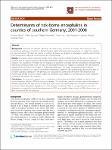Determinants of tick-borne encephalitis in counties of southern Germany, 2001-2008
Kiffner, Christian
Zucchini, Walter
Schomaker, Philipp
Vor, Torsten
Hagedorn, Peter
Niedrig, Matthias
Rühe, Ferdinand
Background: Tick-borne encephalitis (TBE) virus can cause severe symptoms in humans. The incidence of this vector-borne pathogen in humans is characterised by spatial and temporal heterogeneity. To explain the variation in reported human TBE cases per county in southern Germany, we designed a time-lagged, spatially-explicit model that incorporates ecological, environmental, and climatic factors. Results: We fitted a logistic regression model to the annual counts of reported human TBE cases in each of 140 counties over an eight year period. The model controlled for spatial autocorrelation and unexplained temporal variation. The occurrence of human TBE was found to be positively correlated with the proportions of broad-leafed, mixed and coniferous forest cover. An index of forest fragmentation was negatively correlated with TBE incidence, suggesting that infection risk is higher in fragmented landscapes. The results contradict previous evidence regarding the relevance of a specific spring-time temperature regime for TBE epidemiology. Hunting bag data of roe deer (Capreolus capreolus) in the previous year was positively correlated with human TBE incidence, and hunting bag density of red fox (Vulpes vulpes) and red deer (Cervus elaphus) in the previous year were negatively correlated with human TBE incidence. Conclusions: Our approach suggests that a combination of landscape and climatic variables as well as hostspecies dynamics influence TBE infection risk in humans. The model was unable to explain some of the temporal variation, specifically the high counts in 2005 and 2006. Factors such as the exposure of humans to infected ticks and forest rodent population dynamics, for which we have no data, are likely to be explanatory factors. Such information is required to identify the determinants of TBE more reliably. Having records of TBE infection sites at a finer scale would also be necessary.
Dateien zu dieser Publikation
Keine Lizenzangabe

